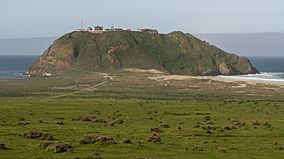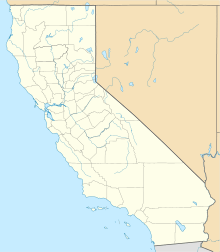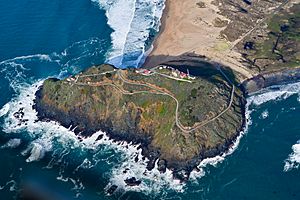Point Sur State Historic Park facts for kids
Quick facts for kids Point Sur State Historic Park |
|
|---|---|

Point Sur from California State Route 1
|
|
| Location | Monterey County, California, United States |
| Nearest city | Carmel, California |
| Area | 92 acres (37 ha) |
| Established | 1986 |
| Governing body | California Department of Parks and Recreation |
Point Sur State Historic Park is a special park in California. It's located on the beautiful Big Sur coastline in Monterey County, California. You can find it about 19 miles (31 km) south of Carmel. The park is famous for its historic Point Sur Lighthouse, which was built way back in 1889. This lighthouse is so important that it's listed on the National Register of Historic Places.
Contents
A Look Back in Time
The land where Point Sur is located was first granted in 1834. This happened when Governor José Figueroa gave the land, which was part of Rancho El Sur, to Juan Bautista Alvarado.
Point Sur was known for being a dangerous spot for ships. Many ships had trouble navigating past it. For example, the large steamer USS Ventura was a very fast ship. On April 20, 1875, it left San Francisco with many passengers and a lot of cargo. In a thick fog, the ship hit rocks just north of Point Sur. The ship's captain, George John Fake, was an experienced sailor. He had sailed this route for years. But this was his first trip south of Monterey. The lack of a lighthouse in the area played a big part in this accident. The sinking of the Ventura showed everyone that a lighthouse was badly needed there.
Other ships also got lost or ran aground near Point Sur. These included the S.S. Los Angeles in 1894, the Majestic in 1909, and several others up until the Howard Olson in 1956.
John Bautista Henry Cooper owned the land around Point Sur. He sold a small piece of land on the rocky summit to the United States government. This was for the lighthouse. The sale happened on November 9, 1889. In 1888, Joseph Post won a contract to build the road to Point Sur. This road connected to the existing coastal road that his father had built.
Building the Point Sur Lighthouse
The Point Sur Lighthouse officially opened on August 1, 1889. The lighthouse was in a very remote area. This meant that the people who worked there and their families had to be self-sufficient. They grew their own vegetables because most supplies arrived by ship.
Life was different for children living at the lighthouse. For a while, they stayed with local ranchers during the week to go to school. They would return home on weekends. Sometimes, they even stayed with relatives who lived far away. In 1927, a teacher was assigned to the lighthouse. This teacher taught the six children who lived there. When the main road from Monterey to Big Sur was finished in 1927, children could go to a schoolhouse on Highway 1. By the 1940s, children from the lighthouse joined the larger school in Big Sur.
The waters near Point Sur Lighthouse were also where the United States Navy airship USS Macon (ZRS-5) crashed in 1935. In 1939, the Lighthouse Service became part of the Coast Guard. This made Point Sur Lighthouse property of the Coast Guard. The lighthouse became automated in the late 1960s. This meant it no longer needed a light keeper by 1974. Point Sur State Historic Park was created in 1986 to protect this important site.
In 2000, a nearby area called Naval Facility Point Sur became part of the California State Park system. The U.S. Navy kept just one building there. This new area became part of Point Sur State Historic Park. For some time, the state park even used some of the old navy housing. Today, you can take guided tours of the facility on weekends.
On February 3, 2017, Naval Facility Point Sur was nominated for the National Register of Historic Places. It was chosen because it's one of the last remaining Sound Surveillance System (SOSUS) facilities. This system was used to listen for submarines. It's the only one left on the West Coast.
What's in a Name?
The land formation we now call Point Sur can be seen from the sea for 10 miles (16 km). It was first written about in 1552 by Juan Rodríguez Cabrillo. Later, Sebastian Viscaino visited the area in the early 1600s. His map from 1603 called the point "Punta que Parece Isla." This means "Point that looks like an island." In 1769, explorer Miguel Costansó named it "Morro de la Trompa." This was because it looked like a rock shaped like a trumpet.
The name "El Sur," meaning "The South," was first used for a land grant. This grant, called Rancho El Sur, was given by Governor José Figueroa in 1834. The name of the rock was shortened to Moro Rock. Then, in 1851, the U.S. Coast Survey officially renamed it Point Sur.
Ocean Protection
Point Sur State Marine Reserve and Marine Conservation Area are special underwater areas. They are located offshore from Point Sur Lighthouse. Think of them like underwater parks! These marine protected areas help to keep ocean wildlife safe. They also protect the important marine ecosystems found there.
See also




